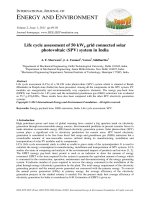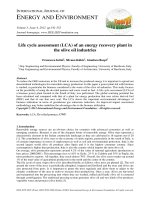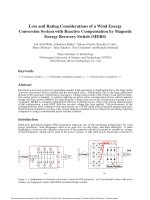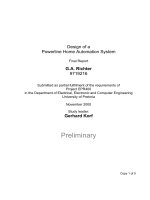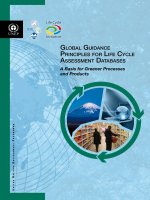kyoungk thesis life cycle assessment of a transparent composite facade system
Bạn đang xem bản rút gọn của tài liệu. Xem và tải ngay bản đầy đủ của tài liệu tại đây (4.2 MB, 196 trang )
Structural Evaluation and Life Cycle Assessment
of a Transparent Composite Facade System
Using Biofiber Composites and Recyclable Polymers
by
Kyoung-Hee Kim
A dissertation submitted in partial fulfillment
of the requirements for the degree of
Doctor of Philosophy
(Architecture)
in The University of Michigan
2009
Doctoral Committee:
Professor Harry Giles, Co-Chair
Professor Richard E. Robertson, Co-Chair
Professor Jean D. Wineman
Associate Professor Gregory A. Keoleian
i
i
© Kyoung-Hee Kim 2009
All Rights Reserved
Dedication
This dissertation is dedicated to my mom,
Byung-Im Choi,
who has instilled in me academic passion and emotional strength.
ii
Acknowledgements
I would like to take this opportunity to express my thanks to everyone who
contributed directly and indirectly to my thesis. First and foremost, I would like to thank
my committee members, especially Professor Harry Giles for his support, patience, and
tremendous counsel as my academic advisor and for sharing his knowledge of the field
with me; Professor Richard Robertson for his constant guidance and critical
encouragement; Gregory Keoleian for his theoretical insight and constructive advice on
my research and Professor Jean Wineman for her steadfast support and infinite wisdom
throughout my graduate studies.
There are several individuals I wish to thank for helping me complete my doctoral
training: Dr. Jong Jin Kim for his powerful words of encouragement and advice about
research methodology; Mark Krecic and Gerald Weston who provided valuable technical
advice and physical assistance when constructing the testing platforms and testing
samples; Dr. Theodore Provder and Sarjak Amin at the Coatings Research Institute at
Eastern Michigan University, who lent their equipment and shared their technical
expertise; Julianna Lieu for her assistance with the metal work; Jeremy Freeman,
Stephanie Driver, Josh Bard, Steve Jelinek, and Erin Putalik at the architecture
department, Eric Heininger and Carrie Bayer at the department of Materials Science and
Engineering, Michelle Cho, Katie Kerfoot, Brandon Cox, John Stepowski, and
Shangchao Lin at the department of Mechanical Engineering, and Han Zhang, Thomas
DiCorcia, Sarah Ann Popp, and Mitsuyo Yamamoto at the School of Natural Resources
and Environment for their support and inspirational work with the 2006 EPA-P3 research;
Jong-Kuk Kim for his invaluable help with conducting final experiments.
iii
I am thankful to the architecture department at the University of Michigan to
provide me continuous financial support and teaching opportunity. I would also like to
thank the faculty, staff, and my colleagues at the architecture department for their advice,
assistance, and encouragement.
Finally, I would like to express my heartfelt gratitude to my beloved family: my
parents and parents-in-laws, who have supported me while I worked to accomplish my
goal, my husband, Yau Shun Hui, and our two sons, Anthony and Henry, who have
tolerated my absence and distraction for many years and who have given me joy and rest
when it was needed. Without you, I would not be here. Thank you.
iv
TABLE OF CONTENTS
Dedication .......................................................................................................................... ii
Acknowledgements .......................................................................................................... iii
List of Figures................................................................................................................... ix
List of Tables ................................................................................................................... xii
List of Appendices.......................................................................................................... xiv
Abstract............................................................................................................................ xv
Chapter 1 ........................................................................................................................... 1
Introduction....................................................................................................................... 1
1.1 Background of the Study .......................................................................................... 1
1.2 Statement of the Problem.......................................................................................... 2
1.3 Research Objectives.................................................................................................. 4
1.4 Significance of the Research..................................................................................... 5
Chapter 2 ........................................................................................................................... 7
Literature Review ............................................................................................................. 7
2.1 Previous Studies on Composite Panel Systems for Building Applications .............. 8
2.2 Transparent Composite Façade System.................................................................. 11
2.2.1 Recyclable Polymers as Skin Materials............................................................ 12
2.2.2 Biofiber Composites as Core Materials............................................................ 21
2.1.3 Bio-Coatings ..................................................................................................... 27
2.2.3 Existing System Review ................................................................................... 27
2.3 Structural Evaluation Framework........................................................................... 30
2.3.1 Strength and Stiffness ....................................................................................... 30
v
2.3.2 Impact Performance.......................................................................................... 36
2.4 Environmental Performance Evaluation Framework ............................................. 40
2.4.1 Framework of the Life Cycle Assessment (LCA) ............................................ 40
2.4.2 LCA Application to a Building Window System ............................................. 44
2.5 Conclusions............................................................................................................. 45
Chapter 3 ......................................................................................................................... 48
Structural Performance Evaluation of a TCFS ........................................................... 48
3.1 Structural Design of a TCFS................................................................................... 48
3.1.1 Strength and Deflection Requirements of a TCFS ........................................... 48
3.1.2 Design Load Verification ................................................................................. 49
3.1.3 Structural Properties of a TCFS........................................................................ 51
3.1.4 Bending Stress and Deflection Check of a TCFS Panel................................... 54
3.1.5 Structural Design Conclusions ......................................................................... 55
3.2 Installation of a New Testing Facility..................................................................... 56
3.2.1 Overview of Testing Facility Design................................................................ 56
3.2.2 Structural Analysis of Testing Frame ............................................................... 58
3.2.3 Fabrication of Testing Frame............................................................................ 62
3.2.4 Frame Installation Conclusions ........................................................................ 63
3.3 Static Performance .................................................................................................. 64
3.3.1 Static Testing Apparatus and Specimens.......................................................... 64
3.3.2 Static Testing Procedure ................................................................................... 66
3.3.3 Static Testing Result ......................................................................................... 67
3.3.4 Finite Element Analysis.................................................................................... 79
3.3.5 Static Performance Evaluation Conclusion ...................................................... 84
3.4 Impact Performance Evaluation.............................................................................. 85
3.4.1 Impact Testing Apparatus and Specimens........................................................ 85
3.4.2 Impact Testing Procedure ................................................................................. 87
3.4.3 Impact Testing Results ..................................................................................... 89
3.4.4 Impact Testing Conclusions ............................................................................. 98
3.5 Charpy Impact Performance ................................................................................... 99
vi
3.5.1 Charpy Impact Tester and Specimens .............................................................. 99
3.5.2 Charpy Impact Testing Procedure .................................................................. 101
3.5.3 Charpy Impact Testing Result ........................................................................ 101
3.5.4 Charpy Impact Testing Conclusion ................................................................ 102
3.6 Conclusions........................................................................................................... 103
Chapter 4 ....................................................................................................................... 105
Life Cycle Assessment (LCA) ...................................................................................... 105
4.1 Goal and Scope Definition.................................................................................... 105
4.1.1 Goal and Scope ............................................................................................... 105
4.1.2 System Boundaries ......................................................................................... 106
4.1.3 Functional Unit ............................................................................................... 107
4.1.4 Assumptions and Limitations ......................................................................... 110
4.2 Life Cycle Inventory (LCI)................................................................................... 113
4.2.1 Energy Inputs.................................................................................................. 114
4.2.3 Environmental Emissions ............................................................................... 120
4.3 Life Cycle Impact Assessment (LCIA) ................................................................ 121
4.4 Sensitivity Analysis .............................................................................................. 123
4.4.1 Pre-use Phase: Improved life expectancy ....................................................... 124
4.4.2 Post-Use Phase: Recycling as an Alternative to Incineration......................... 125
4.5 LCA Conclusions.................................................................................................. 127
Chapter 5 ....................................................................................................................... 132
Conclusions and Future Work..................................................................................... 132
5.1 Structural Conclusions.......................................................................................... 132
5.1.1 Problem Statement.......................................................................................... 132
5.1.2 Summary of Research Activities .................................................................... 132
5.1.2 Structure Conclusions and Recommendations ............................................... 134
5.1.4 Study Limitations and Future Work ............................................................... 137
5.2 LCA Conclusions.................................................................................................. 137
5.2.1 Problem Statement.......................................................................................... 137
vii
5.2.2 Summary of Research Activities .................................................................... 138
5.2.3 LCA Conclusions and Recommendation........................................................ 139
5.2.4 Study Limitations and Future Work ............................................................... 140
APPENDICES ............................................................................................................... 142
BIBLIOGRAPHY ......................................................................................................... 171
viii
List of Figures
Figure 1.2.1
Simplified Sectional View of TCFS.......................................................... 4
Figure 1.3.1
Overview of Research Areas..................................................................... 6
Figure 2.1.1
Composite Construction of Spacecraft (a) ................................................ 9
Figure 2.2.1.1 Impact Resistance of PC, PMMA, and Glass.......................................... 14
Figure 2.2.1.2 Creep Modulus of SAN at Various Time and Stress Levels................... 15
Figure 2.2.1.3 Yellowness Index (a) and Haze of PC and PMMA................................. 16
Figure 2.2.2.1 Overview of Biofiber Composite Material Components ........................ 22
Figure 2.2.2.2 E-modulus Comparison of Biofiber Composites .................................... 23
Figure 2.2.2.3 Discoloration of Jute Composites after Outdoor Exposure..................... 24
Figure 2.2.2.4 Pictorial Ratings of Microbial Degradation: ........................................... 26
Figure 2.2.3.1 ClearShade IGU Assembly and Application in Mexico City.................. 28
Figure 2.2.3.2 ClearShade IGU Energy Performance Values ........................................ 29
Figure 2.2.3.3 Louvers-Integrated IGU: Summer (left) and Winter (right) ................... 30
Figure 2.3.1.1 Transformed Section for Equivalent Moment......................................... 32
Figure 2.3.1.1 An Effective Thickness Calculation Diagram......................................... 36
Figure 2.3.2.1 Shot Bag Impactor for Simulating Human Body Impacts ...................... 37
Figure 2.3.2.2 Shot-Bag Impact Modes.......................................................................... 38
Figure 2.3.2.3 Human Engineering Data ........................................................................ 38
Figure 2.3.2.4 Charpy Impact Machine and Specimen Set-Up ...................................... 39
Figure 2.3.2.5 Fracture Patterns of Laminated Glass (a) and Tempered Glass (b) ........ 40
Figure 2.4.1.1 LCA Procedure in accordance with ISO 14040 ...................................... 41
Figure 2.4.1.3 System Boundary Example of an LCA for a Plastic Sheet ..................... 42
Figure 2.4.1.3 Flow Diagram of Life Cycle Inventory Analysis.................................... 43
Figure 3.1.2.1 An Office Building Enclosed with TCFSs Located in Detroit, MI......... 50
Figure 3.1.2.2 Varying Wind Loads across the Building Façade ................................... 51
ix
Figure 3.1.3.1 Transformed Section Using the E-modulus of PMMA........................... 52
Figure 3.1.3.2 Plan (a) and Section (b) Details of a TCFS ............................................. 53
Figure 3.2.1.1 Overview of Testing Frames ................................................................... 57
Figure 3.2.2.1 Sectional Properties of Testing Frames................................................... 59
Figure 3.2.2.2 Impact Load (34 kN) Set-Up in STAAD.Pro.......................................... 60
Figure 3.2.2.3 Bending Moment Diagram Under Impact Load...................................... 61
Figure 3.2.2.4 Axial Fore Diagram Under Impact Load ................................................ 61
Figure 3.2.2.5 Displacement Diagram Under Impact Load............................................ 62
Figure 3.2.3.1 Fabrication Process of Testing Frames ................................................... 63
Figure 3.3.1.1 Static Test Set-Up.................................................................................... 64
Figure 3.3.1.2 Installation Position of Loading Jack and Displacement Gauges ........... 65
Figure 3.3.1.3 Two-edge (a) and Four-edge (b) Supported Conditions ......................... 65
Figure 3.3.2.1 TCFS (a) and Laminated Glass (b) Test Set-Up ..................................... 66
Figure 3.3.3.1 Bending Stresses Comparison of a TCFS ............................................... 68
Figure 3.3.3.2 Radius of Curvature (ρ) and Displacement (δ)........................................ 69
Figure 3.3.3.3 Displacement Comparison of a TCFS..................................................... 70
Figure 3.3.3.4 Bending Stress Comparison of Laminated Glass .................................... 71
Figure 3.3.3.5 Displacement Comparison of Laminated Glass ...................................... 72
Figure 3.3.3.6 Bending Stress Comparison of Fully Tempered Glass ........................... 73
Figure 3.3.3.7 Displacement Comparison of Fully Tempered Glass.............................. 74
Figure 3.3.3.8 Structural Properties of TCFS that Affects Bending Stiffnesss .............. 76
Figure 3.3.3.9 Bending Stress Comparisons of a TCFS ................................................. 77
Figure 3.3.3.10 Displacement Comparisons of a TCFS ................................................... 78
Figure 3.3.4.1 Model Set-Up in STAAD.Pro ................................................................. 80
Figure 3.3.4.2 STAAD.Pro Results of a Two-Edge Supported TCFS ........................... 81
Figure 3.3.4.3 STAAD.Pro Results of a Four-Edge Supported TCFS ........................... 82
Figure 3.4.1.1 Overview of Impact Test Frames (a) and Drop Height (b) ..................... 86
Figure 3.4.1.2 Overview of Impact Test Instrumentation............................................... 87
Figure 3.4.2.1 Impact Test Set-Up: Fully Tempered Glass (a) and TCFS (b)................ 88
Figure 3.4.3.1 Breakage Modes of Laminated Glass...................................................... 90
Figure 3.4.3.2 Displacement (a) and Strain (b) Output of Laminated Glass .................. 91
x
Figure 3.4.3.3 Breakage Modes of Fully Tempered Glass ............................................. 92
Figure 3.4.3.4 Displacement and Strain Outputs of Fully Tempered Glass ................... 93
Figure 3.4.3.5 Fracture Patterns (a) of PMMA Skin at 457 mm Drop Height ............... 95
Figure 3.4.3.6 Post Breakage Modes of TCFS at 457 mm Drop Height ........................ 96
Figure 3.4.3.7 Displacement (a) and Strain (b) Output of TCFS.................................... 97
Figure 3.4.3.8 Displacement Comparisons between Glass and TCFS ........................... 98
Figure 3.5.1.1 Charpy Impact Tester (a) and Specimen Set-Up Plan View (b) ........... 100
Figure 3.5.2.1 Broken PMMA After Calibrating the Charpy Impact Tester................ 101
Figure 3.5.3.1 Charpy Impact Strength as a Fuction of Time ...................................... 102
Figure 4.1.2.1 Overview of the System Boundaries of the LCA.................................. 107
Figure 4.1.3.1 Functional Unit (FU) of TCFS and GCWS........................................... 108
Figure 4.1.3.2 Material Mass Per TCFS and GCWS.................................................... 109
Figure 4.1.3.3 Material Mass Input Composition Per Functional Unit ........................ 110
Figure 4.1.4.1 Travelling Distance Between Builidng Site and Suppliers ................... 111
Figure 4.2.1.1 Embodied Energy Distributions of TCFS and GCWS Per FU ............. 114
Figure 4.2.1.2 An Office Building Set-Up in eQUEST................................................ 116
Figure 4.2.1.3 Use Phase Energy of TCFS and GCWS Per FU ................................... 118
Figure 4.2.1.4 Total Life Cycle Energy Input of TCFS and GCWS Per FU ................ 120
Figure 4.2.3.1 CO2 Emissions of TCFS and GCWS Per FU ....................................... 121
Figure 4.3.1
Global Warming Potential of TCFS and GCWS Per FU ...................... 122
Figure 4.4.1.1 Sensitivity Analysis Results for Pre-Use Phase .................................... 125
Figure 4.4.2.1 Sensitivity Analysis Results for Post-Use Phase................................... 126
Figure 4.5.1
LCA and Sensitivity Analysis Comparisons ......................................... 130
xi
List of Tables
Table 2.2.1.1 Material Density of PC, PMMA, and Glass ............................................. 13
Table 2.2.1.2 E-modulus of PC, PMMA, and Glass based on Tensile Test................... 13
Table 2.2.1.3 Coefficient of Thermal Expansion of PC, PMMA, and Glass ................. 17
Table 2.2.1.5 Water Absorption of PC, PMMA, and Glass ........................................... 18
Table 2.2.1.6 Flammability of PC, PMMA, and Glass................................................... 18
Table 2.2.1.7 U-factor of PC, PMMA, and Glass........................................................... 19
Table 2.2.1.8 SHGC of PC, PMMA, and Glass.............................................................. 20
Table 2.2.1.9 VLT of PC, PMMA, and Glass ................................................................ 20
Table 2.2.1.10 Embodied Energy of PC, PMMA, and Glass ........................................... 21
Table 2.2.2.1 Mechanical Properties of Biofiber Composites
.................................... 23
Table 2.2.2.2 Weathering of Biofiber Composites ......................................................... 24
Table 2.2.2.3 Water Absorption of Different Biofiber composites ................................ 25
Table 2.3.1.1 Tabulated Values for Four-Edge Supported Plates .................................. 34
Table 2.3.1.2 Formulas for Four-Edge Supported Plates ............................................... 35
Table 3.1.3.1 Sectional Properties of a TCFS Panel....................................................... 52
Table 3.1.4.1 Material Properties of TCFS Components ............................................... 54
Table 3.1.4.2 Summary of Stress and Deflection of a TCFS.......................................... 55
Table 3.3.3.1 Bending Stress Comparison of a TCFS .................................................... 68
Table 3.3.3.2 Displacement Comparison of a TCFS ...................................................... 69
Table 3.3.3.3 Bending Stress Comparison of Laminated Glass ..................................... 71
Table 3.3.3.4 Displacement Comparison of Laminated Glass ....................................... 72
Table 3.3.3.5 Bending Stress Comparison of Fully Tempered Glass............................. 73
Table 3.3.3.6 Displacement Comparison of Fully Tempered Glass............................... 74
Table 3.3.3.7 Bending Stress Comparisons of a TCFS .................................................. 77
Table 3.3.3.8 Displacement Comparisons of a TCFS.................................................... 78
xii
xii
Table 3.3.4.1 Material Properties of PMMA Skin and Cardboard Core ........................ 80
Table 3.3.4.2 Stress and Displacement Comparisons..................................................... 81
Table 3.3.4.3 Stress and Displacement Comparisons..................................................... 83
Table 3.5.3.1 Measured and Charpy Impact Strength of PMMA................................. 102
Table 4.1.3.1 Functional Unit (FU) of TCFS and GCWS for Baseline LCA............... 107
Table 4.1.3.2 Material Inputs of TCFS and GCWS Per Functional Unit (FU) ............ 109
Table 4.1.4.1 Major Assumptions and Limitations of the LCA study.......................... 112
Table 4.2.1
Life Cycle Inventory Data for Energy Inputs and GHG Emissions ....... 113
Table 4.2.1.1 Pre-Use Phase Energy of TCFS and GCWS per FU .............................. 115
Table 4.2.1.2 Office Building Information for eQUEST Simulation ........................... 116
Table 4.2.1.3 Site Energy Consumed by End Uses of TCFS and GCWS Per FU........ 117
Table 4.2.1.4 Primary Energy Conumption of TCFS and GCWS Per FU ................... 118
Table 4.2.1.5 Post-Use Energy Consumption of TCFS and GCWS per FU ................ 119
Table 4.2.1.6 Total Life Cycle Energy Input of TCFS and GCWS Per FU ................. 119
Table 4.2.3.1 Pollutant Emissions of TCFS and GCWS Per FU.................................. 121
Table 4.3.1
Global Warming Potential for 100-Year Time Horizon......................... 121
Table 4.3.2
Global Warming Potential of TCFS and GCWS Per FU ....................... 123
Table 4.4.1
Key Factors for Sensitivity Analysis ...................................................... 123
Table 4.4.1.1 Sensitivity Analysis Results for Pre-Use Phase...................................... 124
Table 4.4.2.1 Sensitivity Analysis Results for Post-Use Phase .................................... 126
Table 4.5.1
LCA and Sensitivity Analysis Comparisions ......................................... 129
Table 4.5.2
Summarized Comparisions of LCA and Sensitivity Analysis................ 131
xiii
List of Appendices
Appendix A Material Properties ................................................................................... 143
Appendix B Characteristics of Polymers and Glass ..................................................... 144
Appendix C Biofiber Composites vs. Synthetic Fiber Composites.............................. 145
Appendix D Wind Load Calculation in accordance with ASCE 7-02 ......................... 146
Appendix E Joint Shear Testing ................................................................................... 148
Appendix F
LRFD for Testing Frame Members ......................................................... 150
Appendix G Charpy Impact Testing Report Provided By Bodycote Testing Group ... 154
Appendix H Energy Use and Environmental Emission Inventory Data ...................... 163
Appendix I Energy Performance Value Verification Process ..................................... 166
xiv
xiv
Abstract
Structural Evaluation and Life Cycle Assessment
of a Transparent Composite Facade System
Using Biofiber Composites and Recyclable Polymers
By
Kyoung-Hee Kim
Co-Chairs: Harry Giles and Richard E. Robertson
A composite façade system concept was developed at the University of Michigan
by Professor Harry Giles that considered the use of various transparent and composite
materials in building construction. Particular aspects of this transparent composite façade
system (TCFS) were investigated in this dissertation and involved the use of recyclable
polymers and biofiber composites. This dissertation addresses research questions related
to structural and environmental performance of the transparent composite façade system
(TCFS) compared to a glass curtain wall system (GCWS). In order to better understand
the context for the TCFS and establish performance evaluation methods, an extensive
literature review was conducted focusing on material performance, structural
xv
performance requirements, life cycle assessment (LCA) techniques, composite panel
principles, product surveys and building codes. Structural design criteria were established
for the TCFS with respect to the strength and stiffness requirements of the International
Building Code (IBC). A new testing frame was fabricated and installed at the
architectural department of the University of Michigan to conduct static and impact tests
in accordance with Safety Performance Specifications and Methods of Test (ANSI Z97.1).
Initial static tests were carried out to measure bending stiffness of TCFS specimens in
order to compare the results with theoretical predictions. Impact tests were also carried
out to examine whether TCFS specimens conformed to the safety glazing criteria
specified in ANSI Z97.1. In addition, a comparative LCA of a TCFS and a GCWS was
performed on each system to assess their respective environmental implications.
Structural testing results indicated that the bending stiffness according to simple
beam theory is in agreement with measured stiffness under two-edge supported
conditions. Impact tests demonstrated that TCFS specimens satisfy the Class B of the
safety glazing requirements of ANSI Z97.1. Comparative LCA results showed that the
total life cycle energy of the TCFS was estimated to be 93% of that of the uncoated
GCWS and the total emission of kg CO2 equivalent for the TCFS was determined as
89% of the uncoated GCWS. The impact associated with transportation and the end-oflife management was estimated to be insignificant in this study.
xvi
Chapter 1
Introduction
1.1 Background of the Study
At present, the US has only 5% of the world’s population but is responsible for a
quarter of the total world energy consumption and CO2 emissions (EIA, 2007, p. 5-6).
Buildings in the residential and commercial sectors in the US consume 40% of total
energy, 72% of total electricity, and 40% of raw materials while generating 39% of the
US’s CO2 emissions (DOE, 2007, p. 5). 136 tons of construction and demolition (C and
D) waste were generated in the US in 1996 which accounted for more than 40% of total
municipal solid waste in US landfills (Franklin Associates Prairie Village, 1998, p. 2-11,
3-1, 3-10). Further, depending on building type and design life, energy consumption
associated with fabricating building materials vary from 10% for typical office buildings
(Scheuer, Keoleian, & Reppe, 2003) up to 40% for medium density housing over their
total life cycle (Thormark, 2006). Buildings are, therefore, prime candidates for reducing
energy and materials consumption, as well as lowering the environmental impact
associated with building material production, operation, and disposal. Possible
opportunities for improving the current situation include enhanced building energy
performance, on-site energy generation using renewable energy resources, sustainable
construction methods and waste management, and the use of recycled materials.
There is increasing interest in the application of new materials in contemporary
buildings in the pursuit of more creative forms and lightweight materials. Polymers,
which offer great potential applications for buildings, have been used in manufacturing
industries for some time. However, the long term durability of polymers in outdoor
applications still needs to be improved. With advances in polymer technology, new
1
applications are opening up where polymers are used in conjunction with various
reinforcements and coatings. TCFS were originally developed with the intention of
creating new possibilities for building enclosures and at the same time addressing
improvements in building use energy, recyclability and use of renewable sources as a
means by which to reduce the energy and landfill waste noted above. TCFS incorporate
recyclable polymers and biofiber composites made out of renewable fiber reinforcements,
as an alternative to conventional glazing systems for buildings. It is recognized that since
polymers are recyclable, and their thermal conductivity (0.2 W/m-K) is five times less
than that of glass (1 W/m-K), they offer great potential to be used in buildings to reduce
waste and energy use. This researcher investigated the performance of these new
materials in a typical TCFS application according to standard assessment methods and
compared its performance with that of a typical glass façade system.
1.2 Statement of the Problem
The building envelope as a mediator between dynamic external climates and static
indoor conditions is subjected to various factors depending on the region in which the
building is located, including heat, ultraviolet (UV) radiation, moisture, sound, wind, and
seismic situations. While the use of opaque walls primarily focuses on security, privacy,
and energy conservation, glazing walls provide daylighting, natural ventilation, and
visual transparency. Glass is the most commonly used material in glazing systems, and
various structural, thermal, acoustic, visual, and detailing issues have been continuously
challenged in order to achieve high performance buildings.
The structural attributes of glass material are of concern because of impact
resistance. Glass fails catastrophically when it is subjected to excessive bending stress,
thermal shock, or imposed strain (Institution of Structural Engineers (ISE), 1999, p. 22).
Further, when fully tempered glass is used in a glazing wall to provide higher strength,
the inclusion of nickel sulphide can cause spontaneous breakage long after installation
due to its slow growth within the glass over time (Loughran, 1999, p. 15). This continues
to be a problem unless the glass is subjected to a heat soaking process prior to installation.
The use of extra-large windows is still challenging due to handling and installation issues,
2
and requires more metal frames to hold the glass, adding more material and weight to the
building.
In addition to these structural challenges, the environmental impact of using a
glass façade system is of increasing concern. Glass windows are responsible for $40
billion in energy loss in US buildings annually (Selkowitch, 2008, p. 6). Various coating
such as low-e and reflective coatings, solar control films, surface treatment (frit), and/or
laminated glass with high performance interlayer are widely available to create energy
efficient windows. However, these methods are beginning to limit the benefit of winter
sun and daylight for buildings in cold climates, adding energy consumption during
heating seasons (Carmody, Selkowitz, Lee, Arasteh, & Willmert, 2004, p. 14). Certain
reflective coatings can cause glare for occupants of other buildings (Carmody, Selkowitz,
Lee, Arasteh, & Willmert, 2004, p. 88). Therefore, glazing systems need to be more
carefully considered for location, use, and solar orientation, the studies of which are not
addressed in this research.
Glazing systems are structurally and environmentally challenging, and therefore,
research on alternative glazing systems is essential to increase the knowledge base of
structural and energy performance of the building envelope. The research investigation
focused on studying the performance characteristics of recyclable polymers, which also
possess greater impact resistance compared to glass. A transparent composite façade
system (TCFS) incorporates a stiff layered panel system through composite interaction
between a core and skin configuration, similar to most composite honeycomb panel
systems used in lightweight construction. In this instance, a biofiber composites core is
bonded between two polymer skins, and offers ecological advantages due to its
renewability, recyclability, and biodegradability. The TCFS referred to here, uses a
transparent recyclable polymer skin and opaque biofiber composites core, and was
investigated for its structural integrity and environmental impact. Figure 1.2.1 illustrates a
simplified sectional view of a TCFS showing heat transfer characteristics depending on
the sun’s position.
3
Biofiber
composites
core
90 °F
Biofiber
composites
core
75 °F
0 °F
70 °F
Recyclable
polymer skin
Recyclable
polymer skin
Summer
Winter
Figure 1.2.1 Simplified Sectional View of TCFS
1.3 Research Objectives
The primary objectives of this research are to explore the influence of recyclable
polymer and biofiber composites material properties on the performance of TCFS and to
establish a simple structural design procedure for building applications. The structural
investigations also include static and impact load testing. Life Cycle Assessments (LCA)
are carried out on a TCFS and a glass curtain wall system (GCWS) to compare their
relative environmental impact
This study specifically addresses the following research questions:
1) Building Materials Investigation
a. How do polymers differ from glass with respect to their material properties?
What are the pros and cons of each?
b. What are the mechanical properties of polymers and biofiber composites?
2) Structural Design of Transparent Composite Façade System (TCFS)
a. What are the structural principles of a composite panel system?
b. What are the structural design criteria and design procedures for a TCFS?
3) Structural Performance Evaluation of TCFS
4
a. What is the stiffness of TCFS and are theoretical predictions consistent
with experimental results?
b. What is the impact behavior of a TCFS system?
4) Comparative Life Cycle Assessment (LCA)
a. What is the life cycle energy consumption and corresponding CO2
emissions of TCFS compared to GCWS?
b. To what extent does the prediction of product life influence the overall life
cycle assessment?
Figure 1.3.1 shows the outline of a research method and procedure to achieve the
discussed research objectives.
1.4 Significance of the Research
This research investigates some of the key performance characteristics of
emerging materials in buildings and carries out baseline comparisons with a typical glass
wall system towards assessing any advantages provided by an alternative polymer- and
biofiber composites-based glazing system. The primary assessment criteria for this
research are related to renewable, recyclable and biodegradable materials that will
contribute to reducing energy consumption, waste generation, and environmental
pollution. In particular, biofiber composites have the potential to contribute towards
greater agricultural diversity, as a non-crop based renewable material, through their
extensive use in future building products.
In addition, research on the structural and environmental attributes of TCFS will
enhance the knowledge base for building envelope and green building practice including
the use of lightweight sustainable materials. The LCA methodology used in this research
will also contribute towards a better understanding of how the LCA method can better
quantify the overall energy performance of a building envelope by considering the entire
life cycle.
5
Research Objectives
Literature Review
Building Material Performance
Mechanical properties
Scratch resistance
Water absorption
Thermal expansion
Weatherability
Flammability
Embodied energy
Building Façade Performance
Structural
Impact
Thermal
Moisture
Environmental
Existing product review
Sustainability
Life cycle assessment
(LCA) technique
LCA application to a
glazing system
Research Method: Experimental/Analytical Methods
Experimental/Analytical Methods
Analytical Method
Evaluation of structural properties
of TCFS in the areas of:
LCA of a TCFS:
Life cycle inventory (LCI)
Life cycle impact assessment
(LCIA)
Life cycle result interpretation
Strength
Stiffness
Impact resistance
Charpy impact resistance
And comparison with the
performance of a GCWS
And comparison with the
performance of a GCWS
Results and Discussion
Structural Performance
Sustainability
Embodied energy
Energy consumption
Environmental impacts
Strength
Stiffness
Flexural behavior
Impact resistance
Conclusions
Figure 1.3.1 Overview of Research Areas
6
Chapter 2
Literature Review
Glass has been used as a load bearing material in building façades since the mid20th century (ISE, 1999, p. 145). As the popularity of a glass façade in buildings
continues to rise (Sutherland, 2008, p. 122), the structural safety and the environmental
performance of a glass façade system increase in importance. Two major structural
challenges of a glass façade system are its low impact resistance and brittleness, while
heat loss and gain through a glass wall is another challenge from an environmental
perspective.
In the past, the opaque parts of a building—such as the walls and roofing
members—were made of composite panel construction. These panels composed of
various skin and core materials are favored in the architecture industry due to their
beneficial structural and thermal properties (Hough, 1980; Chong & Hartsock, 1993;
Pokharel & Mahendran, 2003; Boni, Franscino, & Almeida, 2003). Many studies have
been focused on investigating the structural behaviors of composite panels under static
and dynamic loads using analytical, numerical, and experimental methods. The extensive
research conducted on opaque composite panels is beneficial to the research of a
transparent composite façade system (TCFS) because it helps understanding inherent
structural and thermal potentials of a TCFS and similar research methodologies can be
employed to measure the performance metrics of a TCFS.
A less stiff transparent polymer has been configured to a very stiff material by
sandwiching with a biofiber composites core, which formed a transparent composite
façade system (TCFS). A TCFS was designed as a stiffer, safer, energy-efficient and
lightweight alternative to glass for building façade applications. To measure whether
these goals were met, it is necessary to understand the performance of existing glass
7
systems. The three structural performance metrics that are examined in this research are
strength, stiffness and impact behavior. The sustainability metrics specifically focus on
energy consumption and CO2 emissions and are analytically investigated using the life
cycle assessment technique. The final two sections of this chapter establish a theoretical
framework to measure the aforementioned façade performance.
2.1 Previous Studies on Composite Panel Systems for Building Application
The first practical application of composite panels was for World War II aircrafts,
and later, these same types of panels were used on the Apollo spacecraft (Davis (Ed.),
2001, p. 1). The double sandwich shell in the Apollo spacecraft was primarily used for
weight reduction and strong and stiff construction (Davis (Ed.), 2001, p. 1). The shell of
the Apollo spacecraft, as shown in Figure 2.1.1, consisted of two layers of thin composite
panels that were connected by spacers. The outer layer was composed of a 0.038 mm
thick plastic honeycomb core sandwiched between two 0.021~0.51 mm thick steel facing
sheets. The construction of the inner layer was similar, except the skin was made of a thin
aluminum panel rather than a sheet of steel facing. Since the 1960s, composite panels
have been widely used in industrial and commercial buildings, with the first architectural
application in the Sainsbury Centre for Visual Arts in Norwich, UK, which was designed
by Foster Associates in 1977 (Davis (Ed.), 2001, p. 45). The size of each panel was 1.8 m
x 1.2 m and 55 mm thick, and all four sides of the panel were prefinished with extruded
frames in order to provide fixing mechanisms and a weatherproofing membrane against
an aluminum back-up carrier system (Brookes, 1990, p. 161).
Composite panels have been proven to offer a high strength- and stiffness-toweight ratio. Many researchers have studied the structural behaviors of composite panels
used for building applications. The majority of the research that has been conducted has
focused on defining simplified design equations or numerical simulation methods to
provide time efficient, accurate tools that were validated through experimental results.
The studies also have focused on the global and local buckling behaviors of a composite
panel system. For building applications, the skin material, which must be relatively
strong and durable, is often made of such products as a concrete panel, a piece of coldformed steel or sheet metal, medium density fiber board, or glass fiber reinforced gypsum
8


